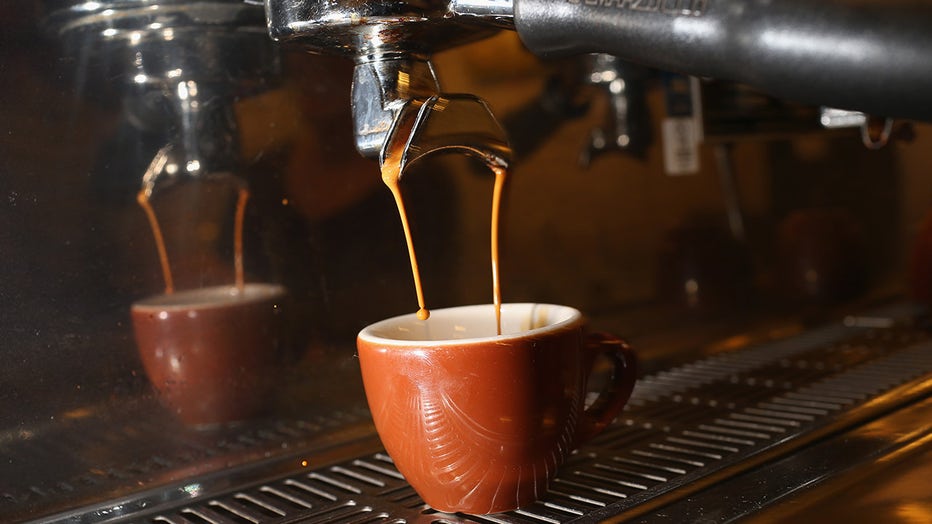$4 per cup? See the cheapest and most expensive states for a cup of coffee
Does $4 sound like a "latte"?
A new report recently examined coffee and tea trends in all 50 states to understand how much Americans pay per cup.
In its Q1 2024 Restaurant Trends Report, the company Toast analyzed the average price of regular coffee, cold brew, lattes and tea in each U.S. state.
The financial services company found that guests across the country paid an average of $3.08 for a cup of regular coffee, $5.14 for cold brew, $5.46 for lattes and $3.74 for tea during the first quarter of 2024.
Coffee most expensive in Hawaii, California
The study found that Hawaii had the most expensive coffee in the country, with an average price of $4.89 — nearly $5 a cup and approximately 59% higher than the national average.

An espresso coffee is seen at Eternity Coffee Roasters during National Coffee Day. (Credit: Joe Raedle/Getty Images)
California was the second-most expensive, averaging about $1 less than Hawaii at $3.88, which was still 26% higher than the national average.
On the other end of the spectrum, the average price for a cup of coffee in Nebraska in Q1 2024 was just $2.12 — 31% lower than the national average.
Toast noticed similar trends with cold brew and tea, with Hawaii and California at the top end of pricing, but Alaska bumped California out of the number two spot for the most expensive latte at $6.09.
RELATED: Cocoa prices continue to spike: What's driving costs higher?
The average price for a latte was a whopping $6.69 in Hawaii and $6.09 in Alaska.
According to Toast, the sky-high prices of lattes in Hawaii and Alaska are likely driven by the price of milk and the remoteness of the two states. Prices for milk in these states are among the highest in the nation, and shipping goods such as espresso to these regions only increases those prices.
The company also found tea was more popular than coffee in 31 states.
Most expensive states for cup of coffee
1. Hawaii
2. California
3. Washington
4. Arizona
5. Massachusetts
6. Colorado
7. Utah
8. Florida
9. Vermont
10. New Mexico
Cheapest states for cup of coffee
1. Nebraska
2. Montana
3. Kanasas
4. North Dakota
5. West Virginia
6. South Dakota
7. Iowa
8. Wisconsin
9. Mississippi
10. Indiana
Inflation, extreme weather affects coffee prices
This study underscores an increased focus on the cost of beverages as inflation remains high and extreme weather affects harvests.
Cultivating cocoa and coffee requires very specific temperature, water and soil conditions. Now, more frequent weather events including heat waves, heavy rainfalls and droughts are damaging harvests and crippling supplies amid a continuing demand from consumers.
"Adverse weather conditions, mostly in the Southern Hemisphere, have played an important role in sending several food commodities sharply higher," Ole Hansen, head of commodity strategy at Saxo Bank, told the Wall Street Journal in April.
In 2021, a sustained drought followed by two July frosts blew a hole in Brazil’s coffee output, immediately sending wholesale prices for the popular Arabica bean to more than $2 per pound. The frost would significantly affect the 2022-23 harvest, according to Carlos Mera, who analyzes the coffee markets at Rabobank.
Inflation is also having an impact. While inflation has fallen considerably from a peak of 9.1%, progress has largely flatlined since last summer, keeping prices high.
RELATED: Best time to drink coffee: Experts spill the beans
Maher Youssef, owner of Pluto Organic Cafe in Seattle, Washington, told Fox News that his coffee shop has relied on credit cards to pay for costs as inflation has surged.
However, Youssef explained that he could only raise prices minimally in order not to scare away his customers.
"We’re a small business, a small corporation, a small cafe. I can’t raise the prices. I can't put the coffee for, like, you know, a couple bucks more. The maximum we can raise the price is — what — 50 cents, a dollar? Because if you put the prices crazy, people are not going to buy from you," he said.
This story was reported from Los Angeles.

